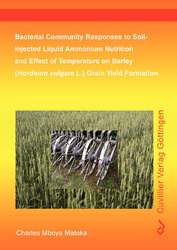| Departments | |
|---|---|
| Book Series (96) |
1379
|
| Nachhaltigkeit |
3
|
| Gesundheitswesen |
1
|
| Humanities |
2367
|
| Natural Sciences |
5407
|
| Mathematics | 229 |
| Informatics | 319 |
| Physics | 980 |
| Chemistry | 1364 |
| Geosciences | 131 |
| Human medicine | 243 |
| Stomatology | 10 |
| Veterinary medicine | 108 |
| Pharmacy | 147 |
| Biology | 835 |
| Biochemistry, molecular biology, gene technology | 121 |
| Biophysics | 25 |
| Domestic and nutritional science | 45 |
| Agricultural science | 1004 |
| Forest science | 201 |
| Horticultural science | 20 |
| Environmental research, ecology and landscape conservation | 148 |
| Engineering |
1793
|
| Common |
98
|
|
Leitlinien Unfallchirurgie
5. Auflage bestellen |
|
Advanced Search
Bacterial community responses to Soil-injected liquid ammonium nutrition and effect of temperature on barley (Hordeum vulgare L.) grain yield formation (English shop)
Charles Mboya Matoka (Author)Preview
Table of Contents, Datei (55 KB)
Extract, Datei (57 KB)
Injection of concentrated liquid ammonium nutrition into soil is an agricultural practice aimed at mitigating nitrogen losses. In Germany, it is referred to as controlled uptake long term ammonium nutrition (CULTAN) technique. In many soils, nitrate is
mobile because as an anion, it is not bound to negatively charged surfaces of clay minerals or organic soil compounds. In contrast to phosphate, it is not specifically adsorbed. Nitrate fertilization may thus result in leaching and presents a potential environmental hazard. Ammonium ions, on the other hand, may be unspecifically bound to negatively charged surfaces or even fixed in inter-layers of 2:1 clay minerals.
Following the injection of concentrated liquid ammonium into soil, ammonium is the predominant N nutrition form suggesting its stability in soil. After 30 days, though ammonium persisted in the soil, its concentration had drastically decreased. Unspecifically bound ammonium may be exchanged and readily oxidized to nitrate by nitrifying bacteria. Bacterial community occurrence within the perceived toxic ammonium injection-zones facilitated transformation of ammonium to nitrate. This resulted into a rapid reduction of ammonium due to microbial as well as crop uptake. Along side the reductions in ammonium concentrations, nitrate concentrations increased rapidly as the season progressed. The incorporation of nitrification inhibitor (Nitrapyrin®) improved the stability of injected liquid ammonium by suppressing the nitrification process. However, the inhibitor did not express any direct effect on ammonium concentration reductions. It suppressed the transformation of ammonium into nitrate. Non-incorporation of the inhibitor caused the formation of high concentrations of nitrate. The transformation of ammonium to nitrate under CULTAN fertilization suggests that the technique offers mixed nitrogen nutrition contrary to earlier assumptions that it supplies predominantly ammonium. The nitrogen switch from predominant ammonium to mixed nitrogen through the availability of partial nitrate is deemed to have played a role in the alleviation of ammonium toxicity symptoms commonly associated with crops fertilized with ammonium. Though mixed nitrogen nutrition is usually reported to produce superior grain yields, none was recorded in this study.
This study has provided the first molecular evidence demonstrating the occurrence of bacterial communities in CULTAN-fertilized soils contrary to the presumption that ammonium injected zones remain highly toxic and never allow any microbial inhabitation and/or any substantial activity. In addition to this, the presumed toxic zones with high ammonium concentrations and acidic pH levels supported the highest diversity of bacterial communities. This diversity shifted spatio-temporally with regard to distance from injection zones and time after the injection was performed. Analysis of ammonia
monooxygenase sub-unit A (amoA) gene revealed the occurrence of ammonia oxidizing bacteria (AOB) within these same toxic zones where their functional role is thought to have mainly been nitrogen transformation, especially in non-inhibitor incorporated ammonium treatments. Despite the presence of a large bacterial diversity in the early part of the season, it decreased as the season progressed. Though temporal bacterial community shifts also occurred (30 and 60 days after fertilization) with decreasing ammonium concentration and changing pH levels. The banding pattern seemed to have been restored to the original patterns of nitrate and non-fertilized control. This suggests the occurrence of an endogenous stability of the bacterial community structure over the
season. This is an indication that CULTAN fertilization effects are not permanent, but only transient. The population of ammonia oxidizing bacteria in the treatment experiencing ‘mixed nitrogen nutrition’ had the highest estimates of population abundance. This illustrates that high nitrification rates per se did not support the high population occurrence, but rather supported root exudation, which could have influenced the rhizosphere by improving microbial nutritional resources and suitable niches. It can be generally concluded from this study that growth temperatures interact with CULTAN-injected liquid ammonium to cause a suite of growth responses such as growth duration alterations, tillering and ear formation which have a great impact on grain and biomass yields. Crop growth rate among different phenological stages influenced grain yield and yield forming-factors which significantly affected yield output. The role of temperature on microbial activity, especially the nitrification of injected liquid ammonium can not be ruled out. The possible occurrence of mixed nitrogen and crop growth durations could have also contributed to superior grain and biomass yields under low temperatures. These findings could be useful temperate and tropical regions.
| ISBN-13 (Printausgabe) | 3867275076 |
| ISBN-13 (Hard Copy) | 9783867275071 |
| ISBN-13 (eBook) | 9783736925076 |
| Language | English |
| Page Number | 160 |
| Edition | 1 |
| Volume | 0 |
| Publication Place | Göttingen |
| Place of Dissertation | Giessen |
| Publication Date | 2008-02-01 |
| General Categorization | Dissertation |
| Departments |
Domestic and nutritional science
Agricultural science Environmental research, ecology and landscape conservation |








